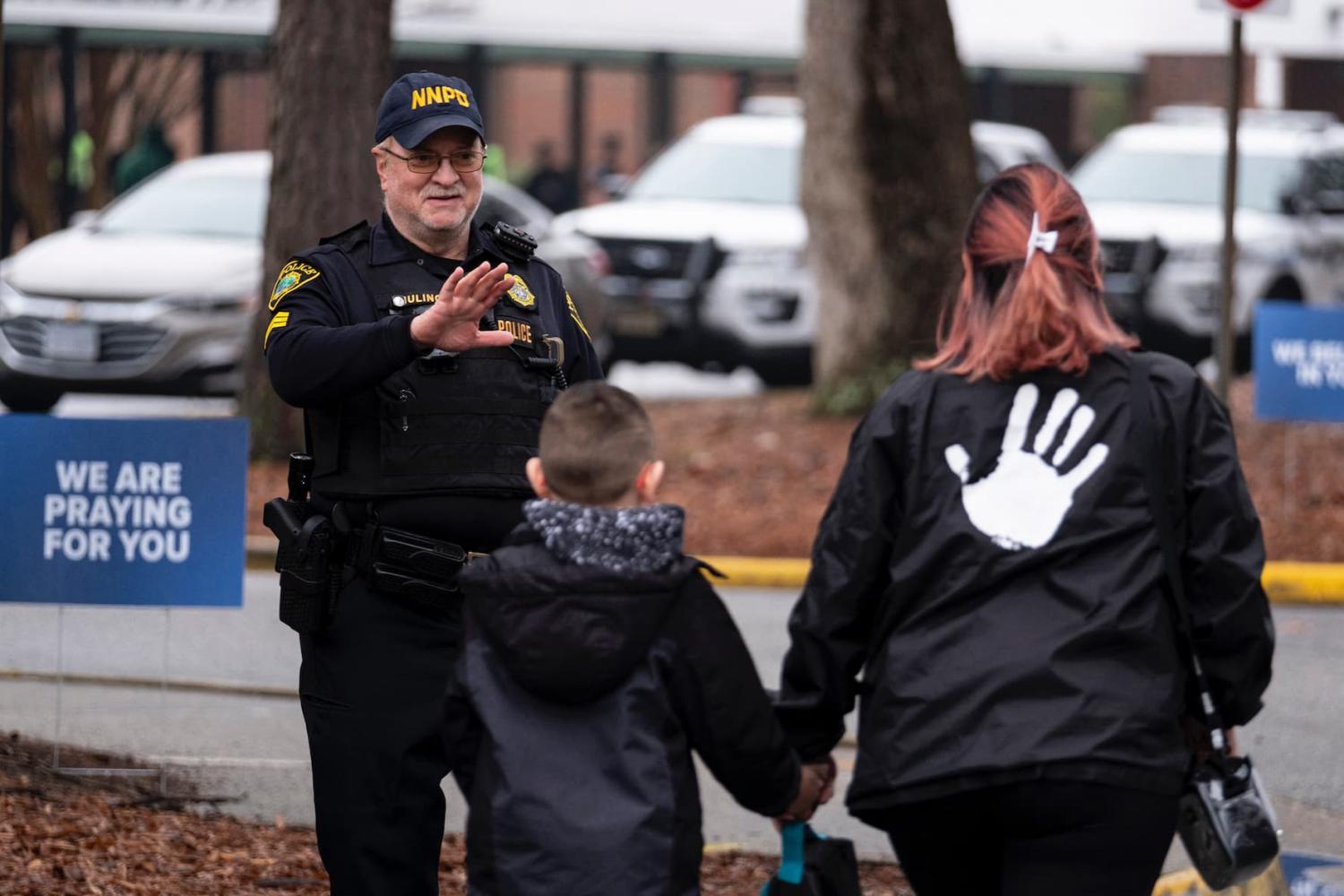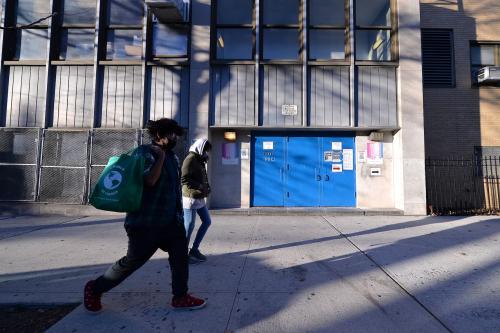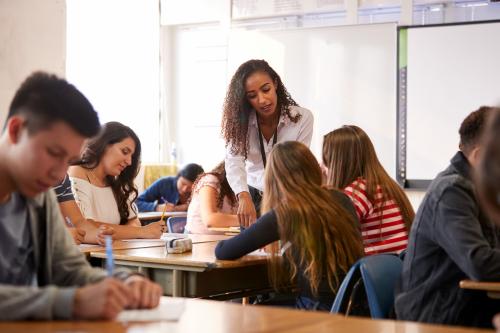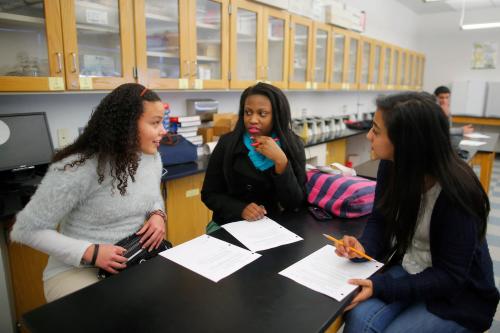During the summer of 2020, many school districts shifted away from using school resource officers (SROs) in response to widespread concerns over policing and racial justice that had swept across the country. Within a month of the death of George Floyd, Minneapolis Public Schools terminated their longstanding contract with the Minneapolis Police Department. A handful of other large districts—including Denver, Seattle, Milwaukee, and San Francisco—shortly followed suit in removing police officers from their schools.
Three years later, the tide is turning in the opposite direction. Many districts that planned to restructure their SRO programs have struggled to implement meaningful changes. Other districts have reversed course entirely, such as Denver Public Schools, which announced a plan to reinstate SROs across school campuses this fall. Texas has gone so far as to mandate that every school campus must have an armed police officer. It’s not hard to see the rationale behind such actions. School shootings continue to happen, and educators have reported grappling with disruptive student behavioral issues that were exacerbated by the pandemic.
This back-and-forth over SRO policies raises a basic—but challenging—empirical question: How do SROs affect school environments and student outcomes? We sought to answer these questions in a recent national study, co-authored with John Engberg and Shawn Bushway. In this post, we describe our findings from that study and consider how local and state governments might strike the right balance with their SRO programs.
A natural experiment in school-based policing
Our study uses data from the 2017-18 wave of the Civil Rights Data Collection, which includes measures of disciplinary incidents, disaggregated by student subgroups, for every public school in the United States. Notably, this is the first national dataset to track the number of full-time-equivalent school law enforcement officers present at each school. The data show that around 41% of high schools, 38% of middle schools, and 17% of elementary schools have an SRO stationed on school grounds at least part time (Figure 1 below).
We are interested in understanding the impacts of these SROs. Simply comparing outcomes at schools with and without SROs can lead to misleading results, since SROs are commonly hired at larger schools with preexisting safety risks or student discipline problems. Therefore, we use a quasi-experimental method called regression discontinuity to estimate causal effects of SROs. This method compares schools scoring just above a score threshold for a federal school-based policing grant program to schools scoring just below that same threshold. These schools should be nearly identical to each other—except that some schools received funding for a new SRO and others didn’t.
Impacts of SROs on school safety
Using this comparison approach, as shown in Figure 2, we find that introducing a new SRO to a school increases the reported number of gun-related offenses by 0.3 incidents per 500 students (a 195% increase from average). Gun-related incidents are rare in schools and include instances of gun possession, threats with a gun, and physical attacks with a gun. This increase in gun-related incidents is consistent with prior research showing that SROs tend to increase reported crime in schools. However, it is unclear whether such changes are explained by (a) actual changes in student behavior, (b) changes to detection and reporting practices induced by the presence of an SRO, or (c) some combination of the two.
Conversely, we find that a new SRO decreases other forms of violent offenses by 2.9 incidents per 500 students (a 30% decrease from average). These other violent offenses include physical attacks without a weapon, threats without a weapon, and other, rarer forms of violence such as sexual assault. This finding lends support to the argument that SROs can help to support safer school environments for students and staff (though it, too, is subject to changes in detection or reporting practices).
Impacts of SROs on student discipline
These reductions in school violence come at a serious cost, our study finds. One additional student is arrested at school or referred to law enforcement per 500 students per year (a 52% increase) following the introduction of a new SRO. This effect corroborates a key mechanism hypothesized as part of the school-to-prison pipeline—that SROs increase the likelihood that minor offenses committed in school lead to formal criminal justice contact.
SROs also change the disciplinary structure within schools. An additional SRO increases the number of students receiving out-of-school suspension by 12 students (a 62% increase) and the number of students receiving expulsion by around one student (a 90% increase) per 500 students. The magnitudes of these impacts are startling given that SROs do not have the formal authority to suspend or expel students—these decisions lie under the purview of school administrators. However, other research has found similar effects, and SROs clearly become involved in minor student disciplinary matters in nuanced but important ways.
These effects of SROs on discipline and arrest rates vary significantly across different populations of students. Adverse effects are more pronounced for male students than for female students. They are also more pronounced for students with disabilities. Effects of an SRO on suspension, expulsion, and arrest are all nearly three times larger for students with disabilities than for students without disabilities. SRO presence also disproportionately harms Black students. Out-of-school suspensions increase by 1.9 times more, expulsions by 3.3 times more, and arrests by 2.5 times more for Black students than for white students upon introduction of an SRO to the school. These disparate increases take place amid an environment where Black students already receive disproportionate punishment for the same school-based offenses.
These patterns generally emphasize the centrality of race to questions involving school policing. As the continuing controversy over policing reforms makes clear, student race is a critical dimension for evaluating police in schools. Data show that Black students are less likely to feel safe in the presence of SROs, and SROs are more likely to view students as threats in racially diverse urban schools than in affluent, white suburban schools. School districts and states should take these issues of racial bias in policing into account as they consider whether to further invest in SROs and/or whether to implement policies governing the use of SROs.
Practical considerations for school districts and states
High-profile school shootings are a common motivation for increasing the use of police officers in schools. However, these events are relatively rare, and police officers do much more in schools than prepare for active shooters.
Our study and related research suggest several policy recommendations:
First, memoranda of understanding (MOUs) between school districts and police departments should clearly delineate the roles of SROs and ensure that they are not pulled into school disciplinary responses to minor infractions. These MOUs should be clearly communicated not only to SROs but also to school administrators such that they know when and how to appropriately involve an SRO in student issues.
Second, SROs should receive basic, specialized training that better prepares them to build relationships with students and de-escalate situations that can arise with children and adolescents. Even though SROs funded through the Community Oriented Policing Services Hiring Program are required to complete basic training, there is currently no national training guidance for SROs, and training requirements vary widely across states.
Third, education agencies should collect and make available data on the placement and activities of SROs. This is not done currently in part because SROs are typically not school district employees; they are police agency employees. Better data would allow more rigorous review and evaluation of SROs at different levels of schooling and under different training or accountability structures.
Fourth, school districts should carefully weigh the pros and cons of SROs—relative to alternative approaches—given the needs of their students and communities. In some districts, alternative safety personnel such as security guards or mobile law enforcement units could better meet school needs. Investing in alternative student support services, such as social work and mental health professionals, could also improve school climate and safety over the long term – and in doing so reduce the need for school policing altogether.
The Brookings Institution is committed to quality, independence, and impact.
We are supported by a diverse array of funders. In line with our values and policies, each Brookings publication represents the sole views of its author(s).









